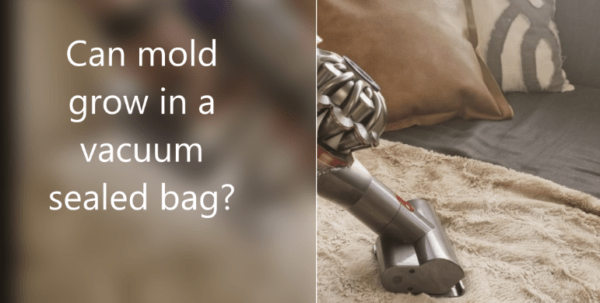Table of contents

Vacuum sealing is one way you can keep the contents of bags safe from mold. Here, we will discuss can mold grow in a vacuum sealed bag.
No, vacuum sealing a bag will create an airtight space.
Mold spores cannot grow in a vacuum sealed bag because they require oxygen to grow. Just like people, mold needs air to breathe and grow. Vacuuming out the air in a bag creates an uninhabitable environment for mold spores to live and thrive. In fact, vacuuming out the air inside of your bag will kill any bacteria or germs that may be present on its surface as well! That being said, there’s no need to worry about having food contaminated by what’s growing outside of your food storage container or plastic wrap—mold only grows when moisture comes into contact with it; if it can’t get wet (and if you’re storing foods properly), then there’s nothing for it to eat!
Mold spores inside the bag
This means that any mold spores inside the bag will be unable to grow. The same is true for bacteria and viruses. Since these do not survive in a vacuum, they cannot survive on food either.
However, if you want to keep your food fresh longer, there are other ways to preserve foods than just using a vacuum sealer. For example, by freezing your food in small portions using freezer bags or containers and then storing them in an airtight freezer container or chest freezer (if applicable), you can effectively extend the life of your food for several years after it has been opened or cooked/cooked and refrigerated until use as desired — depending on how much room there is left over after packaging everything properly!
Mold spores on the outside of the bag
However, if there were mold spores on the outside of the bag before it was vacuum sealed, they could still grow.
You are right that mold spores can be found in many places and food is no exception. Spores are the reproductive bodies of fungi, and they can easily be transferred from one place to another through the air or on surfaces. For example, if you were to take a knife out of your kitchen drawer and then go eat lunch at your desk (like I just did), there would be very small amounts of mold spores on that knife that would transfer onto whatever I ate for lunch—and it could grow into an infestation if left unchecked.
So what does this have to do with vacuum sealing? Well, even though processing food in a bag will help kill most mold spores (and also make sure it doesn’t get contaminated with any additional ones), doing so won’t necessarily kill all of them—especially if they’re already present on the surface of the packaging itself. In addition, because vacuum sealing bags traps moisture inside them, this creates an ideal environment for molds to grow if they’re present—even if there aren’t any visible signs yet!
Store bags in a clean and dry place
It is important to store bags in a clean and dry place to reduce the risk of mold growth on their surface. Mold can grow under certain conditions, so it’s important to avoid storing your bags in humid areas or in direct sunlight. In addition, high levels of moisture (such as those found near water pipes) and dusty areas also present an increased risk for mold growth on your vacuum-sealed bags.
Vacuum sealing can keep the contents of bags safe
One way you can keep the contents of bags safe from mold is by vacuum sealing them. Vacuum sealing keeps air out, so there’s no place for mold to grow. It also helps keep air in, which keeps food fresh longer. You can use this method to store many types of food safely, including meat and cheese.
Conclusion
Vacuum sealing can be a great way to keep your food from spoiling. It’s important to keep in mind that the vacuum sealer does not disinfect items or remove any mold spores that may already be present on them; it only removes air from inside the bag. That means if there are mold spores on the outside of your bag before it’s sealed, they could still grow inside once you open it up again later! For this reason, we recommend storing vacuum-sealed bags in an area where there isn’t much humidity—such as in an unused closet or similar dry place where they won’t be exposed to moisture levels high enough for microorganisms like fungi spores (which includes most types of fungi).
